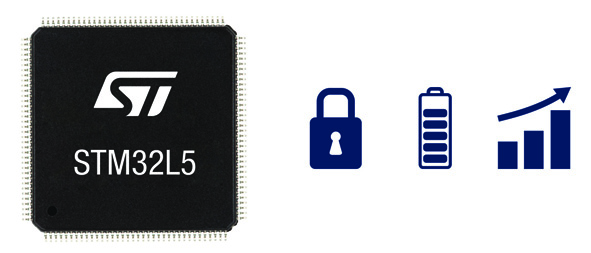STM microcontrollers protect IoT applications
- February 18, 2020
- imc

Swiss electronics firm ST Microelectronics has announced low-power microcontrollers that emphasise security to assure better protected IoT-connected applications.
Operating at clock frequencies to 110MHz, the STM32L5 MCUs start from the Arm Cortex-M33 32bit risc core with Arm TrustZone hardware-based security. First conceived for equipment such as desktops, mobile devices and communication infrastructure, trusted computing authenticates devices connected to a network by creating a protected execution environment for cyber protection and sensitive code (cryptography and key storage) that blocks attempts to corrupt devices or software. A second, independent, execution environment allows for the running of untrusted code.
To this foundation, STM has added the freedom to include or exclude each IO, peripheral or area of flash or SRAM from TrustZone protection, allowing sensitive workloads to be fully isolated for increased security. In addition, the company has engineered TrustZone to ensure support for secure boot, special read-out and write protection for integrated SRAM and flash, and cryptographic acceleration, including AES 128/256bit key hardware acceleration, public key acceleration, and AES-128 on-the-fly decryption, to protect external code or data.
The STM32L5 also supports active tamper detection and secure firmware installation. With this attention to security, the STM32L5 has been certified to PSA Certified level two.
“As IoT and embedded devices increase in intelligence and functionality, security must be built in from the ground up,” said Thomas Ensergueix, senior director at Arm. “The STM32L5 series makes it easier for developers to build trusted PSA Certified devices based on the Arm Cortex-M33 processor, providing a robust and secure foundation for devices ranging from consumer products to industrial equipment.”
On top of this protection and design flexibility, STM has mixed in its proprietary low-power expertise through techniques such as adaptive voltage scaling, real-time acceleration, power gating and multiple reduced-power operating modes, to enable the MCUs to increase performance and run-times, whether powered by coin cells or even through energy harvesting.
In addition, an efficient switched-mode step-down regulator can be powered up or down on-the-fly to improve low-power performance when the VDD voltage is high enough. The resulting ULP Mark scores, which are key measures of low-power efficiency based on real-world benchmarks developed by EEMBC, are said to be excellent: 370 ULP Mark-Core Profile and 54 ULP Mark-Peripheral Profile at 1.8V.
“As a market leader in MCUs with a strategic focus in areas like smart cities, smart buildings and smart industry, STM recognised the importance of a series of MCUs that combined world-class ultra-low-power consumption with industry-leading security and data protection, for mission-critical applications and at-the-edge node processing,” said Ricardo De Sa Earp, microcontroller division general manager for STM. “Applying STM’s expertise in ultra-low-power design and processing technologies and adding our security and data protection on top of the solid foundation of Arm TrustZone and the outstanding STM32 ecosystem, the STM32L5x2 MCUs are ideal for industrial IoT applications – metering, health (human or machine) monitoring, mobile point-of-sale – that require reliability and security.”
The MCUs have 512kbyte dual-bank flash that allows read-while-write operation to aid device management and the flash ensures a high level of safety by supporting error correction code with diagnostics. There is also a 256kbyte-SRAM and features to support high-speed external memory including single, dual, quad or octal SPI and Hyperbus flash or SRAM, and an interface for SRAM, PSRAM, NOR, NAND or FRAM.
Digital peripherals include USB Full Speed with dedicated supply, allowing users to keep USB communication even when the system is powered at 1.8V, and a UCPD controller compliant with USB Type-C Rev 1.2 and USB Power Delivery Rev 3.0 specifications.
Smart analogue features include an analogue-to-digital converter, two power-gated digital-to-analogue converters, two low-power comparators, and two operational amplifiers with external or internal follower routing and programmable-gain amplifier capability.
As part of the STM32 MCU family, the series is supported by the STM32 ecosystem and features its own STM32 Cube L5 one-stop-shop software package, which includes hardware abstraction layer and low-level drivers, Free RTOS, Trusted Firmware-M (TF-M), secure boot and secure firmware update, USB-PD device driver, Mbed TLS and Mbed Crypto, Fat FS file system, and touch sensing drivers.
In addition, more than 300 project examples can run on the STM32L552E-EV evaluation board, STM32L562E-DK discovery kit and Nucleo-L552ZE-Q. These projects can be compiled with the Arm Keil development tool, IAR or STM32 Cube IDE toolchains, and are delivered with a STM32 Cube MX configuration file, enabling customisation and code update.
The MCUs are in full production and available in standard temperature grade from -40 to +85˚C for consumer and commercial applications, or high-temperature grade from -40 to +125˚C for more difficult environments.





